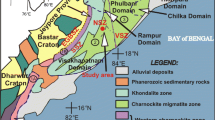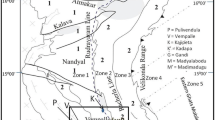Abstract
Partial melting in the middle to lower crustal level produces melts of granitic composition during orogeny. Thrusts play a vital role in their exhumation after consolidation of these granitic melts. In this paper we focus on one such granite along the eastern margin of the Delhi Fold Belt (DFB) rocks near Srinagar, Rajasthan, India. This is the first report of granite within the area and holds a key stratigraphic position in the entire rock package. The said granite is found to be intrusive to the DFB metasediments as well as their basement popularly known as the Banded Gneissic Complex (BGC). We disentangle the deformation fabrics seen within the granite and associated DFB metasediments, suggesting that subsequent to emplacement and consolidation, the granite has co-folded along with the country rocks. Three deformational events could be identified within the DFB metasediments namely, D1D, D2D and D3D. The peak metamorphism was achieved in the D1D event. The granite magma is generated and emplaced late syn-kinematic to D1D and thereafter is deformed by D2D and D3D producing D1G and D2G structural fabrics. These compressive deformations resulted in the collapse of the basin; the combined package of DFB rocks and the granite was thrusted eastwards over the basement rocks. The tectonic transport direction during thrusting is suggested eastwards from our structural analysis. Transverse faults developed perpendicular to the length of the granite have led to partitioning of the strain thereby showing a heterogeneity in the development of fabric within it.











Similar content being viewed by others
References
Biswal T K 1993 Structural history of Barotia group near Barr, Pali District, Rajasthan; Indian Minerals 47 (2) 123–130.
Bouchez J L, Hutton D, and Stephens W E 1997 Granite: From melt segregation to emplacement fabrics; Kluwer Academic Publisher, Dordrecht, 356p.
Brown M 1994 The generation, segregation, ascent and emplacement of granite magma: The migmatite-to-crustally derived granite connection in thickened orogens; Earth Sci. Rev. 36 83–130.
Castro A 1987 On granitoid emplacement and related structures: A review; Geological Rundsch 76 101–124.
Castro A, Fernandez C, and Vigneresse J L 1999 Understanding granites: Integrating new and classical techniques; Geol. Soc. London Spec. Publ. 168 275p.
Choudhary A K, Gopalan K, and Shastry C A 1984 Present status of the geochronology of the Precambrian rocks of Rajasthan; Tectonophys 105 131–140.
Clarke D B 1992 Granitoid rocks; Chapman and Hall, New York, Topics in The Earth Science, 7 283.
Corti G, Moratti G, and Sani F 2005 Relations between surface faulting and granite intrusions in analogue models of strike-slip deformation; J. Struct. Geol. 27 1547–1562.
D’Lemos R S, Brown M, and Strachan R A 1992 Granite magma generation, ascent and emplacement within a transpressional orogen; J. Geol. Soc. London 149 487–490.
Dasgupta N, Sen J, Pal T, and Ghosh T 2009 Nature and time of emplacement of a pegmatoidal granite within the Delhi Fold Belt near Bayalan, Rajasthan, India; Geophysical Research Abstract, EGU, 11.
Dasgupta N, Pal T, Sen J, and Ghosh T 2011 Characteristics of pegmoidal granite exposed near Bayalan, Ajmer district, Rajasthan; J. Earth Syst. Sci. 120 617–626.
Dasgupta N, Mukhopadhyay D, and Bhattacharyya T 2012 Analysis of superposed strain: A case study from Barr Conglomerate in the South Delhi Fold Belt, Rajasthan, India; J. Struct. Geol. 34 30–42.
Deb M, Thorpe R I, Kristic D, Corfu F, and Davis D W 2001 Zircon U–Pb and galena Pb–Pb isotope evidence for an approximate 1.0 Ga terrane constituting the western margin of the Aravalli–Delhi orogenic belt, northwestern India; Precamb. Res. 108 195–213.
Fareeduddin and Kroner A 1998 Single zircon age constraints on the evolution of Rajasthan granulite, In: The Indian Precambrian (ed.) Paliwal B S (Jodhpur: Scientific Publishers), pp. 547–556.
Ferre’ E C, Galland O, Montanari D, and Kalakay T J 2012 Granite magma migration and emplacement along thrusts; Int. J. Earth Sci., doi: 10.1007/s00531-012-0747-6 10.1007/s00531-012-0747-6.
Gangopadhyay A and Mukhopadhyay D 1984 Structural geometry of the Delhi Supergroup near Sendra; In: Geological evolution of peninsular India (ed.) Saha A K, Recent Researches in Geology (Delhi: Hindustan Publishing Corporation), pp. 45–60.
Gopalan K, Trivedi J R, Merh S S, Patel P P, and Patel S G 1979 Rb ±Sr age of Godhra and related granites, Gujarat (India); Proc. Indian Acad. Sci. (Earth Planet. Sci.) 88A 7–17.
Guineberteau B, Bouchez J L, and Vigneresse J L 1987 The Mortagne granite pluton (France) emplaced by pull apart along a shear zone structural and gravimetric arguments and regional implication; Geol. Soc. Am. Bull. 99 763–770.
Gupta P and Bose U 2000 An update of the geology of the Delhi Supergroup in Rajasthan; Geol. Soc. India Spec. Publ. 55 287–306.
Gupta P 2004 Ancient Orogens of Aravalli Region; Geol. Soc. India Spec. Publ. 84 150–205.
Heron A M 1953 The geology of central Rajputana; Geol. Surv. India Memoir 79 389.
Hutton D H W 1982 A tectonic model for the emplacement of the main Donegal granite, NW Ireland; J. Geol. Soc. London 139 615–631.
Hutton D H W 1988 Igneous emplacement in a shear-zone termination: The biotite granite at Strontian, Scotland; Geol. Soc. Am. Bull 100 1392–1399.
Hutton D H W, Dempster T J, Brown P E, and Becker S M 1990 A new mechanism of granite emplacement: Rapakivi intrusions in active extensional shear zones, south Greenland; Nature 343 452–454.
Hutton D H W and Reavy R J 1992 Strike slip tectonics and granite petrogenesis; Tectonics 11 960–967.
Ingram G M and Hutton D H W 1994 The Great Tonalite Sill: Emplacement into a contractional shear zone and implications for Late Cretaceous to Early Eocene tectonics in southeastern Alaska and British Columbia; Geol. Soc. Am. Bull. 106 715–728.
Misra S, Burlini L, and Burg J -P 2009 Strain localization and melt segregation in deforming metapelites; Phys. Earth Planet. India 117 173–179.
Misra S, Burg J -P, and Mainprice D 2011 Effect of finite deformation and deformation rate on partial melting and crystallization in metapelites; J. Geophys. Res. 116. doi: 10.1029/2010JB007865.
Mukhopadhyay D and Dasgupta S 1978 Delhi pre-Delhi relations near Badnor, central Rajasthan; Indian J. Earth Sci. 5 183–190.
Mukhopadhyay D 1989 Structural history of the central section of the Delhi orogenic belt; Proc. 28th Int. Geol. Cong., Abstract 2 479–480.
Mukhopadhyay D and Matin A 1991 Early major folds in the Delhi Supergroup around Hatankhera, Ajmer district, Rajasthan; Indian J. Geol. 63 67–74.
Murthy T V V G R K and Bhargava L R 1972 The deformation of barr conglomerate; J. Geol. Soc. India 13 66–74.
Naha K, Mukhopadhyay D K, Mohanty R, Mitra S K, and Biswal T K 1984 Significance of contrast in the early stages of the structural history of the Delhi and the pre-Delhi rock groups in the Proterozoic of Rajasthan, western India; Tectonophys. 105 193–206.
Naha K and Mohanty S 1988 Response of basement and cover rocks to multiple deformations: A study from the Precambrian of Rajasthan, western India; Precamb. Res. 42 77–96.
Pandit M K, Carte L M, Ashwal L D, Tucker R D, Torsvik T H, Jamtveit B, and Bhushan S K 2003 Age, petrogenesis and significance of 1 Ga granitoids and related rocks from the Sendra area, Aravalli Craton, NW India; J. Asian Earth Sci. 22 363–381.
Paterson S R and Schmidt K 1999 Is there a close spatial relationship between faults and plutons? J. Struct. Geol. 21 1131–1142.
Paterson S R 2006 Close spatial relationship between plutons and shear zones: Comment; Geology 33 72p.
Pitcher W S 1993 The nature and origin of granite (London: Blackie Academic and Professional Press), pp. 183–184.
Richards J P 2001 Discussion of “Is there a close spatial relationship between faults and plutons?” by S.R. Paterson and K.L. Schmidt; J. Struct. Geol. 23 (12) 2025–2027.
Roma’n-Berdiel T, Gapais D, and Brun J P 1997 Granite intrusion along strike-slip zones in experiment and nature; Am. J. Sci. 297 651–678.
Rosenberg C L 2004 Shear zones and magma ascent: A model based on a review of the Tertiary magmatism in the Alps; Tectonics 23 TC3002, doi: 10.1029/2003TC001529.
Roy A B and Kröner A 1996 Single zircon evaporation ages constraining the growth of the Archaean Aravalli craton, northwestern Indian shield; Geol. Mag. 133 333–342.
Rutter E H and Neumann D H K 1995 Experimental deformation of partially molten westerly granite under fluid-absent conditions, with implications for the extraction of granitic magmas; J. Geophys. Res 100 (B8) 15,697–15,715.
Schmidt K L and Paterson S R 2000 Analyses fail to find coupling between deformation and magmatism; EOS 81 (197) 202–203.
Sengupta S 1988 Development of successive sets of structures in a process of continuous deformation: A case study from the Delhi metasediments near Kharwa, Ajmer Dt., Rajasthan, India; Indian J. Earth Sci., 15 116– 131.
Sinha Roy S 1984 Precambrian crustal interaction in Rajasthan, NW India; In: Proc. Seminar on Crustal evolution of Indian shield and its bearing on metallogeny; Indian J. Earth Sci., pp. 84–91.
Sinha-Roy S 1988 Proterozoic Wilson cycles in Rajasthan; In: Precambrian of the Aravalli mountain range (ed.) Roy A B, Geol. Soc. India Memoir 7 95–108.
Sinha-Roy S 2004 Intersecting Proterozoic transpressional orogens, major crustal and suspect terranes in Rajasthan craton: A plate tectonic perspective; Geol. Surv. India Spec. Publ. 84 207–226.
Tobisch O T, Collerson K D, Bhattacharya T, and Mukhopadhyay D 1994 Structural relationship and Sm–Nd isotope systematics of polymetamorphic granitic gneisses and granitic rocks from central Rajasthan, India: Implications for the evolution of the Aravalli craton; Precamb. Res. 65 319–339.
Vigneresse J L 1995 Control of granite emplacement by regional deformation; Tectonophys. 249 173–186.
Volpe A M and Macdougall J D 1990 Geochemistry and isotopic characteristic of mafic (Phulad ophiolite) and related rocks in the Delhi Supergroup, Rajasthan, India: Implications for rifting in the proterozoic; Precamb. Res. 48 167–191.
Acknowledgements
The authors would like to thank the help and support extended by the local people for this work. ND wishes to acknowledge the grant received from UGC (Sanction No. F.PSW-070/09-10 (ERO) dated 18.10.2009). The authors also like to express their gratitude to Dr S Pal of Durgapur Government College, West Bengal (who refrained from being an author of this paper) for discussions held on and off the field. The authors are also thankful to Prof. D Mukhopadhyay for his critical comments, advice and guidance. The suggestions and comments from the anonymous reviewers are also duly acknowledged.
Author information
Authors and Affiliations
Corresponding author
Rights and permissions
About this article
Cite this article
Ruj, T., Dasgupta, N. Tectonic imprints within a granite exposed near Srinagar, Rajasthan, India. J Earth Syst Sci 123, 1361–1374 (2014). https://doi.org/10.1007/s12040-014-0461-9
Received:
Revised:
Accepted:
Published:
Issue Date:
DOI: https://doi.org/10.1007/s12040-014-0461-9




